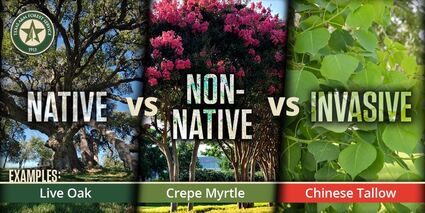Invasive, non-native and native species explained
Last updated 2/21/2023 at 12:30pm
The tree landscape in Texas is made up by a variety of species. From ponderosa pines in West Texas to oaks in Central Texas to dogwoods in East Texas, trees play a vital role in our ecosystem and provide countless benefits. But, what about species that cause negative impacts – invasive species?
Simply put, there are three basic categories of tree species: native, non-native and invasive. Knowing where tree species fall into these categories may seem like trivial information, but species selection is vital to the health of our overall ecosystem.
“All species are good somewhere and all species are bad somewhere,” said Gretchen Riley, Texas A&M Forest Service Forest Systems Department Head. “Planting the right tree in the right place, and avoiding invasive species, helps prevent devastating issues and bolsters the benefits a tree will provide over its lifetime.”
When selecting trees to plant, it’s important to understand where trees fall into these three categories and how that may vary from region to region.
Native species
Native species have evolved and occur naturally in a region, ecosystem or habitat.
Loblolly pines, for example, are native to the East Texas Pineywoods and the Lost Pines regions. The species was here long before civilization and reproduces on its own, creating a stable, self-perpetuating population.
Native species provide a multitude of values to their ecosystem, filling a specific ecological niche. They provide food and shelter for local wildlife, typically require less water once established and often have a better chance of survival because they are well-adapted to their region.
“Native species are resistant and resilient to disturbances that happen in their specific region because they evolved there and have adapted to that habitat,” said Demian Gomez, Texas A&M Forest Service Regional Forest Health Coordinator.
This includes adaptation to temperature variations and extremes, like dry, hot summers or harsh, cold winters, as well as local pests and pathogens because they have co-evolved together, making them more resilient to attacks.
Native species can range in how they behave in their ecosystem, though, and some tend to have aggressive or highly prolific characteristics, according to Gomez.
“An example of an aggressive native species is the winged elm in the Brazos Valley,” said Riley. “While they are native to the region, they take advantage of ideal local conditions during good rainfall years to rapidly reproduce and expand their range in yards and pastures.”
Knowing how species, native or otherwise, perform in your region is key in species selection.
Non-native species
Non-native species do not originate in the area or region where they are found. These species are introduced into an ecosystem, sometimes intentionally and sometimes by accident.
While native species are preferred, non-native species are not necessarily bad for the ecosystem, so long as they do not have a measurable negative impact. Some can even be beneficial to the environment, particularly in urban areas where they increase ecosystem diversity.
“Not all non-natives are invasive,” said Riley. “Many do well without competing with natives and in fact, can fill gaps where some natives may not perform well, such as is the case in urban areas where not only has the native soil been removed for construction purposes, but the natural ecosystem has been altered by the built environment.”
The performance of any species in a specific region may change over time, making non-natives more ideal in particular ecosystems.
“What we call non-native is tricky sometimes,” said Gomez. “Because the natural range of a native species may change over time due to changes in climate or even human disturbance, this is called species migration.”
Ultimately, while native species are preferred when planting trees, there is a time and place for non-native species to add value to an ecosystem’s diversity and resiliency.
Invasive species
Invasive species have two main characteristics: they are non-native to an ecosystem and their introduction causes or is likely to cause harm to the economy, environment or human health.
“Invasive species produce a measurable impact,” said Gomez. “If left unchecked, invasives can threaten native species, biodiversity, ecosystem services, water resources, agricultural and forest production, economics and property values.”
Invasive species have been introduced into an ecosystem, often due to human activity. This can include plants introduced as ornamentals, experimental introductions that escaped containment and species accidentally introduced in imported shipping materials.
Species that are invasive succeed because of their ability to grow in favorable environments and lack of natural predators, competitors and diseases that would normally regulate their populations in their native range.
A significant negative impact of invasives is when they outcompete and reduce native species populations.
“If one species reduces the population of many species, biodiversity is reduced,” said Gomez. “Often, the new, invasive species does not have fruit or vegetation that can be utilized by native insects and wildlife, causing those populations to reduce as well.”
Chinese tallow is extremely invasive to several regions of Texas. It’s invasive because it is a prolific seed producer and adapts well to many conditions, easily outcompeting native vegetation. The species has also negatively impacted wildlife, including the displacement of the Attwater’s prairie chicken.
Invasive species should be avoided when planting and should be removed from the environment when possible.
“The hard part is, once they are in the ecosystem, they are challenging to remove and often mowing them down just makes them come back with a vengeance,” said Riley.
While how to remove invasives can vary with species, manual removal is considered the most effective. Treating stumps and any remaining root system with herbicide may be necessary for mature established trees. A local forester or certified arborist should be contacted for species-specific recommendations.
Learning how to control invasive species around your property and what tools to use to properly remove them will help improve and maintain ecosystem health.
Selecting species
When selecting a tree species to plant, choosing the right tree for the right place is essential. Evaluate and determine the location and the tree’s purpose, then consider tree type by size at maturity.
“When planting trees, native trees are preferred because of their adaptability and resiliency,” said Gomez. “But planting a tree that will add value, perform well in the ecosystem, increase diversity and not become invasive are the major goals.”
Species diversity is critical for the health of our ecosystems, especially when you consider pests and diseases.
“Diversity is a good thing,” said Gomez. “When you have pests and pathogens that affect only one group of species, that’s when non-natives can help increase diversity, creating more resilient urban landscapes.”
In Northeast Texas, native ash trees are being threatened by an incredibly harmful introduced pest, the Emerald Ash Borer, which is detrimental to only the one family of trees.
“If 10 percent of all your trees are one species and you lose them all to a pest or disease, you lose a significant amount of value,” said Riley. “Which means you have to spend more money on heating and air conditioning, water purification, air filtering and health care because all of these benefits are associated with having trees around us.”
In urban forests, the goal is to have a tree population include no more than 5% of one species, 10% of one genus or 15% of one family Riley said. While this can be challenging to achieve, it is a benchmark that ensures urban forest resiliency.
When planting, choose a variety of species to have a diverse and resilient ecosystem, including trees in your yard and overall community.
“The most important thing is to know your region,” said Riley. “There isn’t a one size fits all for Texas. Know what is considered invasive or aggressive in your area and what the needs are for the particular region.”
Finally, avoid planting invasive species. They are harmful to the environment, and if you have invasive species growing, learn how to control and remove them.
For additional information on invasive tree species and common invasive species found in Texas, visit https://tfsweb.tamu.edu/InvasiveTrees/.















Reader Comments(0)